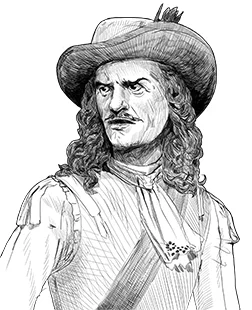Le Gouverneur | The Governor General

Louis de Buade, Count of Frontenac and Palluau (source: "Dessin de Louis de Buade, comte de Frontenac et de Palluau (1622-1698)", digital image of a 2016 drawing by Christian Robert de Massy, Wikimedia Commons, the free media repository, https://commons.wikimedia.org.
The gouverneur, or Governor General of New France, was the representative of the king, the main figure of the colony, and commander in chief of the army. From the noble class, he led the Sovereign Council.
Once a year, the governor had to provide an account to his superior, the Minister of Marine. Together with the intendant, he spearheaded the colony’s development, granted seigneurial land plots and supervised the fur trade. In other words, he was a powerful figure who played a major political and social role in New France.
The position of Governor General of New France was a vice-regal post from 1663 until 1760. It was replaced by the British post of Governor of the Province of Québec following the fall of New France. While the districts of Montreal and Trois-Rivières had their own governors, the Governor General of New France and the Governor of the district of Quebec were the same person.
The Governors General of New France were:
- Augustin de Saffray de Mésy (1663–1665)
- Daniel de Rémy de Courcelle (1665–1672)
- Louis de Buade de Frontenac (1672–1682)
- Antoine Lefèbvre de La Barre (1682–1685)
- Jacques-René de Brisay de Denonville, Marquis de Denonville (1685–1689)
- Louis de Buade de Frontenac (1689–1698)
- Louis-Hector de Callière (1698–1703)
- Philippe de Rigaud Vaudreuil (1703–1725)
- Charles de la Boische, Marquis de Beauharnois (1725–1747)
- Roland-Michel Barrin de La Galissonière (1747–1749)
- Jacques-Pierre de Taffanel de la Jonquière, Marquis de la Jonquière (1749–1752)
- Michel-Ange Duquesne de Menneville (1752–1755)
- Pierre de Rigaud, Marquis de Vaudreuil-Cavagnial (1755–1760)

"Presumed portrait of Charles de la Boische, Marquis de Beauharnois (1671-1749), Governor of New France", digital image of a 1748 oil painting by Robert Tournières, Wikimedia Commons, the free media repository, https://commons.wikimedia.org.

"Chevalier Louis-Hector de Callières", digital image of a 1936 drawing (unknown artist), BAnQ numérique, http://numerique.banq.qc.ca.

"Portrait de Pierre de Rigaud de Vaudreuil (1698-1778)", digital image of a c. 1753 oil painting attributed to Donat Nonnotte, Library and Archives Canada, MIKAN No 2895086, http://collectionscanada.gc.ca.
No comments:
Post a Comment